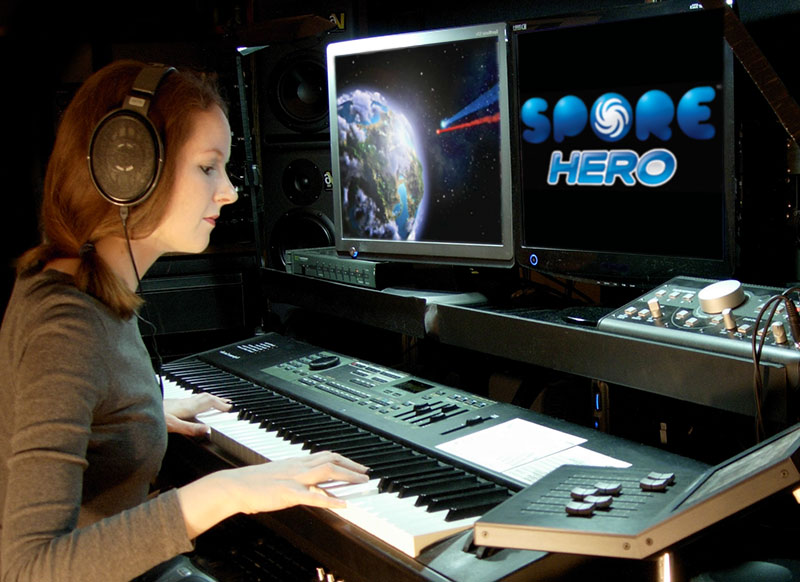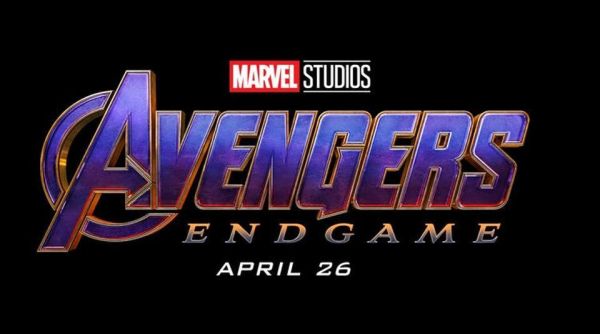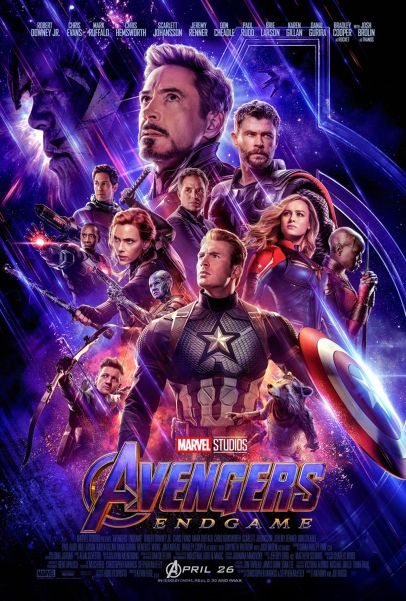Trending
Opinion: How will Project 2025 impact game developers?
The Heritage Foundation's manifesto for the possible next administration could do great harm to many, including large portions of the game development community.

Featured Blog | This community-written post highlights the best of what the game industry has to offer. Read more like it on the Game Developer Blogs or learn how to Submit Your Own Blog Post
Composer Winifred Phillips presents a mini-postmortem on the evolution of a single melodic theme - first composed for EA's Spore Hero, undergoing several in-game variations, and eventually appearing in a trailer for the blockbuster AVENGERS ENDGAME film.


By Winifred Phillips | Contact | Follow
 Hi! I'm video game music composer Winifred Phillips, and sometimes my game music shows up in places I never would have expected. A little over a week ago, while I was eagerly watching an awesome trailer for the just-released blockbuster Avengers Endgame, I was suddenly stunned to hear my own music in it! (I've embedded the Avengers Endgame trailer that features my music at the end of this article.) What made this moment even more jaw-dropping for me was that I had originally composed this music for the video game Spore Hero (a game from Electronic Arts' popular Spore franchise). Just as a reference, here's what the characters look like in Spore Hero:
Hi! I'm video game music composer Winifred Phillips, and sometimes my game music shows up in places I never would have expected. A little over a week ago, while I was eagerly watching an awesome trailer for the just-released blockbuster Avengers Endgame, I was suddenly stunned to hear my own music in it! (I've embedded the Avengers Endgame trailer that features my music at the end of this article.) What made this moment even more jaw-dropping for me was that I had originally composed this music for the video game Spore Hero (a game from Electronic Arts' popular Spore franchise). Just as a reference, here's what the characters look like in Spore Hero:

The style of Spore Hero couldn't be further away from that famous Avengers style, as expertly displayed in the Avengers Endgame trailer. Yet the same music was used for both projects.
 The Spore Hero music I was hearing in the Avengers Endgame trailer was my "Hero Theme," which functions essentially as a leitmotif within the Spore Hero score – it's the central recurring melody in the game.
The Spore Hero music I was hearing in the Avengers Endgame trailer was my "Hero Theme," which functions essentially as a leitmotif within the Spore Hero score – it's the central recurring melody in the game.
By virtue of the theme-and-variation technique, the melody undergoes a gradual transformation from invitingly cute to heroically epic. The Avengers Endgame trailer featured the most dramatic iteration of this theme.
When I recovered from the initial surprise, it occurred to me that a mini-postmortem of this particular melodic theme might be the best way to explore an interesting topic: how does a single theme transform itself from an amiable melody to an avenging one?
I've written about the "theme and variation" technique before, both in these articles and in my MIT Press book, A Composer's Guide to Game Music.
In my book, I described the technique as follows:
"Theme and variation is a key concept for us to fully understand. Like our film and television counterparts, we as video game composers will sometimes create melodies to signify important characters, special events, or particular locations. These melodic themes may then recur within the score, sometimes in an altered form called a variation. This practice does not particularly distinguish our work from that of composers for film and television. However, in video games we often use theme and variation to convey messages to the gamer. Certain musical themes may be used to inform the player that they are achieving successful results, or that they have arrived at a desired destination....The joy of devising variations on a theme is that there are always numerous possibilities, depending on the musical effect we wish to achieve. For the video game composer, the theme-and-variation technique allows us to continue to assert a sense of thematic unity throughout the work while avoiding repetition fatigue."
The Hero Theme in Spore Hero makes its first appearance at the very top of the game, in the opening menu. This track was the first distinct melody that was composed for Spore Hero. Prior to the creation of this track, music production had proceeded for a solid month, focusing solely on components of the dynamic music system that required a very non-melodic approach. In contrast, the opening menu presented the first real opportunity to create an iconic, thematic statement for the game. The composition of this Hero theme included a lot of ascending melodic lines designed to emphasize optimism and positivity. The music was structured in a cheerful major mode, and the style favored world-music rhythms, whimsical instrumentation, and woodwinds. Here's that track (from the official soundtrack album of Spore Hero):
Once this track was complete, work resumed on the dozens and dozens of short music chunks that enabled the dynamic music system to function. Creation of the next full-length melody-driven track for Spore Hero came about a month later, when I recorded and delivered the music for the Creature Editor. Anyone who has played a Spore game will be familiar with the great Creature Editor mechanic. It allows players to create their own unique monster characters using a deep library of body parts that move and function according to the way they're connected together. The music that would play during these creature editing sequences had to be contemplative and low-keyed. Nevertheless, it was important to acknowledge the central melodic Hero theme of the game within the Creature Editor music. Here, that melody appears intermittently as a simple ascending motif (i.e. a melody fragment). Using a recognizable portion of the theme here helps to solidify its importance within the game's score. Here's that music as it is included in the official soundtrack album:
We can hear that this melody fragment now starts to take on iconic overtones, with the upward movement resembling a clarion call. However, the instrumental treatment is still gently playful and light.
The next several months were consumed with lots of music composition for combat and exploration, while still incorporating that short musical motif wherever possible. However, the Hero motif didn't go through any significant variation until composition commenced on the Storytelling track. This music appeared in the game when players received portions of the overall narrative and learned about the importance of their quest. This seemed like a perfect opportunity to expand upon that main Hero theme and surround it with a more complex harmonic structure. Clearing away the whimsy and bright-eyed optimism, the Storytelling music opted for a more serious approach instead. The harmonic underpinnings underwent a radical reimagining. Moving firmly away from the simple major mode cheerfulness it had previously displayed, the iconic Hero theme now incorporates elaborate chord progressions to infuse the music with a sense of development and maturation. Here's that Storytelling version of the Hero theme (titled Sporeward in the official Spore Hero soundtrack album):
After finishing this storytelling music, composition work progressed through the music requirements for all the quests that the main character would undertake throughout the game. Again, it was important to incorporate the short iconic motif wherever possible, lending a sense of unity to the overall score of the game. Along the way, I composed another important melody for this project, so now I’d like to take a short detour and talk a little about that other recurring musical theme – the Nemesis theme. Packed tightly with chord clusters and chromatic runs, the composition structure of the Nemesis theme emphasized a sense of oddness and eccentricity that allowed it to contrast sharply with the hero’s more traditionally harmonious theme. These two melodies essentially ran a parallel course throughout the game as the main character faced off against his evil adversary time and time again. The first appearance of the Nemesis theme favors quirky, whimsical instrumentation and techniques. I’m including the Nemesis theme here because it becomes important as we head towards the final iteration of the Hero theme. So now let’s listen to the Nemesis theme from the Spore Hero soundtrack album:
After completing the Nemesis theme, music composition continued for several more months while work focused on tracks for quests, environments and combat. Finally, the music composition and production schedule reached the penultimate track that plays while the hero rushes towards the climactic end-of-game confrontation. This is the definitive Hero theme of the Spore Hero video game. It takes the optimistic, fanciful melody from the beginning of the game and transforms it into a high-stakes anthem. Most of the overt quirkiness and eccentric instrumentation are gone now, replaced with traditional brass and strings. The world rhythm has disappeared, and military percussion has taken its place. The entire theme has shifted into the minor mode, darkening the texture of the melody and emphasizing a sense of sober importance. In addition, the Nemesis theme breaks in at 1:53, showing the culmination of these two contrasting melodies as they are juxtaposed directly in a single track. Finally, a full choir joins in at 2:35, pushing the intensity still higher. The track has now transformed from a lighthearted and amiable melody to an avenging anthem. First, let's listen to the whole Hero theme as it appears in the Spore Hero soundtrack album:
Here, the theme has shed its fanciful qualities and become an action track suitable for superheroes. With that in mind, let's now see how the Hero Theme worked within the Avengers Endgame trailer:
I hope you've found this mini-postmortem of the Hero Theme from Spore Hero to be an interesting case study of how theme and variation can be useful to us as game composers!
 Popular music from composer Winifred Phillips' award-winning Assassin's Creed Liberation score will be performed live by a top 80-piece orchestra and choir as part of the Assassin's Creed Symphony World Tour, which kicks off in 2019 with its Los Angeles premiere at the famous Dolby Theatre. As an accomplished video game composer, Phillips is best known for composing music for games in five of the most famous and popular franchises in gaming: Assassin’s Creed, LittleBigPlanet, Total War, God of War, and The Sims. Phillips' other notable projects include the triple-A first person shooter Homefront: The Revolution, and numerous virtual reality games, including Scraper: First Strike, Dragon Front, and many more. She is the author of the award-winning bestseller A COMPOSER'S GUIDE TO GAME MUSIC, published by the MIT Press. As a VR game music expert, she writes frequently on the future of music in virtual reality games. Phillips' is a sought-after public speaker, and she has been invited to speak about her work as a game composer at the Library of Congress, the Game Developers Conference, the Audio Engineering Society, the Society of Composers and Lyricists, and many more.
Popular music from composer Winifred Phillips' award-winning Assassin's Creed Liberation score will be performed live by a top 80-piece orchestra and choir as part of the Assassin's Creed Symphony World Tour, which kicks off in 2019 with its Los Angeles premiere at the famous Dolby Theatre. As an accomplished video game composer, Phillips is best known for composing music for games in five of the most famous and popular franchises in gaming: Assassin’s Creed, LittleBigPlanet, Total War, God of War, and The Sims. Phillips' other notable projects include the triple-A first person shooter Homefront: The Revolution, and numerous virtual reality games, including Scraper: First Strike, Dragon Front, and many more. She is the author of the award-winning bestseller A COMPOSER'S GUIDE TO GAME MUSIC, published by the MIT Press. As a VR game music expert, she writes frequently on the future of music in virtual reality games. Phillips' is a sought-after public speaker, and she has been invited to speak about her work as a game composer at the Library of Congress, the Game Developers Conference, the Audio Engineering Society, the Society of Composers and Lyricists, and many more.
Follow her on Twitter @winphillips.
Read more about:
Featured BlogsYou May Also Like